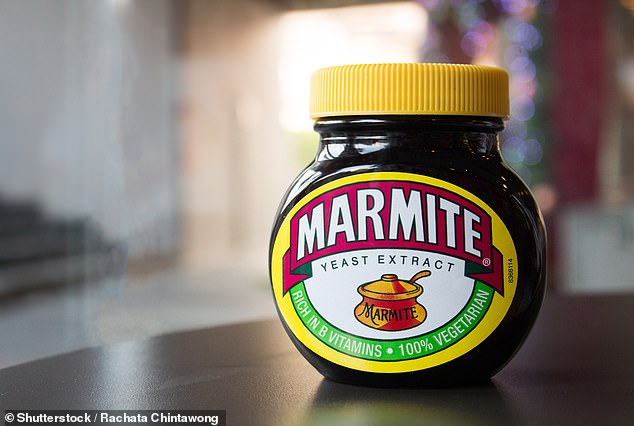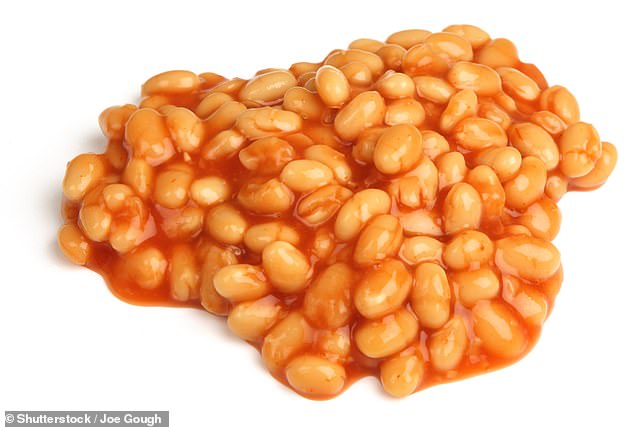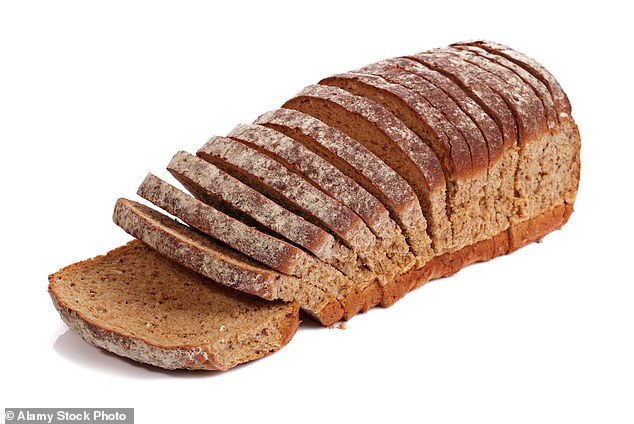Some regard it as one of life’s essentials and love it; others loathe it. But is Marmite good for you?
Or, whisper it — is it one of those ‘ultra-processed foods’ experts say is linked to obesity and other health problems including, as the Mail reported a few days ago, a higher risk of an early death if you have type 2 diabetes?
The cost of Marmite is soaring: a big jar will set you back nearly £6 — good news for manufacturer, Unilever, which has enjoyed rising revenues due to price hikes, it was revealed last week.
And many consumers will not want to give up their favourite spread: not just on account of the taste, but because of the boast that it contains B vitamins.
It also provides potassium — and eating potassium-rich foods could be more beneficial for reducing blood pressure than cutting back on salt, especially for women who eat a lot of salt, according to a study published in the European Heart Journal last year.
(Potassium helps by relaxing blood vessel walls and encouraging the body to excrete sodium.)

Marmite falls into the category of an ultra-processed food, or UPF (stock image)
This was also the finding of an ongoing research programme, involving 96,000 users of the Zoe app, which is led by Professor Tim Spector, an expert in epidemiology and gut health at King’s College London.
Speaking about the results, Professor Spector admitted his surprise about the finding that yeast extract (one of the chief ingredients of Marmite) topped a list of the most potassium-rich foods, with 2,100mg per 100g (this compares to a banana, traditionally thought of as one of the ultimate high potassium foods, with roughly 358mg per 100g).
All of which raises an interesting conundrum: for Marmite falls into the category of an ultra-processed food, or UPF. These are foods that, broadly speaking, come in packets, are subject to industrial processing and contain ingredients you wouldn’t see in a home kitchen (but more on that definition in a moment).
Marmite is made with processed yeast extract — a byproduct of the brewing industry. It is by no means the most extreme example of UPF: others contain a string of unrecognisable ingredients. But does this matter if a food is also providing useful nutrients?
This question is something of a nutritional hot potato. While some experts point to research linking increased UPF intake to a growing list of modern diseases, others say the research doesn’t take into account that people who tend to eat most UPFs may also have other factors which contribute to ill health, such as low income.
Another bone of contention is the definition of a UPF — some say it’s so broad it wrongly vilifies foods that may have some nutritional benefit, such as some sliced supermarket wholemeal bread (which provides fibre), baked beans (also a source of fibre and which count as one of your five a day, on account of the beans and tomato), and Marmite, which, according to its manufacturer, provides 76 per cent of your vitamin B12 needs in one 8g serving (roughly half a tablespoon).

Baked beans are also a source of fibre and count as one of your five a day, on account of the beans and tomato (stock image)
The starting point for what constitutes a UPF is the NOVA classification — the original definition set out by scientists in Brazil in 2009.
NOVA defines UPFs as industrially manufactured products that are made mostly from substances extracted from foods (such as oils, fats, sugar, starch and proteins), or derived from food constituents (such as hydrogenated fats or modified starch) — and with few, if any, unprocessed ingredients.
(This is the definition the UN uses — one leading expert Good Health spoke to was dismissive of a popular definition of UPFs as food with ‘five or more ingredients’, as it’s the nature of the ingredients, not the number, that’s significant). As this stands, a mug of instant vegetable soup, for example, has the same classification as an iced doughnut.
This kind of anomaly led to the Scientific Advisory Committee on Nutrition (SACN), an official body that provides ‘independent scientific advice’ to the Government, saying last month that the NOVA UPF classification groups together foods ‘with differing nutritional attributes’.
‘People assume that nutritional content is taken into account when foods are being determined as ultra-processed, and it isn’t,’ says Professor Judy Buttriss, chair of the Academy of Nutrition Sciences’ board of trustees and former director general of the British Nutrition Foundation.
She thinks the NOVA UPF classification is ‘unhelpful, as it draws in nutritionally important foods, as well as those high in sugar, saturated fat or salt.
‘In a sense, it is implying that a healthy food that has been processed in a factory is automatically different, nutritionally speaking, from the same food made by me in my kitchen.’
What’s more, she argues, some UPFs have valuable nutritional benefits. ‘Take some reduced-sugar, high-fibre breakfast cereals such as wholewheat flakes. These would be classed as a UPF, despite contributing important dietary fibre and other nutrients.
‘And the important thing when you take something out of your diet is what you replace it with —giving your child a high-fibre cereal, which technically is a UPF, is likely to be a more nutritious start to the day than alternatives such as a homemade sweet muffin,’ adds Professor Buttriss. What’s more, products such as Marmite may not be all bad as it provides ‘a wide range of B vitamins such as B1, B2, B3 folic acid and B12 — but it is high in salt’ — salt does not count as a UPF ingredient.
This view was reflected by a study published in the Journal of Nutrition in June, which found that it was perfectly possible to build a week’s worth of 2,000 calorie-a-day menus that fitted in with a ‘healthy dietary pattern’, with NOVA-defined UPFs making up over 80 per cent of the intake.
It wasn’t perfect, said the US-based authors — primarily as it had ‘an insufficient amount of whole grains’ and an ‘excess of sodium’, but the menu provided adequate amounts of ‘all macro- and micronutrients except vitamin D, vitamin E and choline’.
But other experts, including Dr Kiara C-M Chang, a research fellow at the School of Public Health at Imperial College London, say we must not forget that UPFs are ‘industrial products’, made ‘through deconstructing foods into nutrients, often chemically modifying them, and re-combining them back together so there is little original food left in a UPF product’.

The definition of a UPF — some say it’s so broad it wrongly vilifies foods that may have some nutritional benefit, such as some sliced supermarket wholemeal bread (which provides fibre) (stock image)
Dr Chang, who earlier this year published research on a possible link between UPFs and cancer, argues that ‘UPFs are designed to displace all other minimally processed foods and freshly cooked meals that our traditional dietary pattern was largely based on’.
What’s more, she says, ‘UPFs are cheap and convenient — some people may perceive this as a good thing, but UPFs can be priced competitively because of the low-cost [industrially modified] ingredients they’re produced with.’
If there is an argument about the definition itself, the UPF classification has helped focus research on the adverse effects of these highly processed foods, suggests Tim Lang, a professor emeritus of food policy at City University of London. ‘By having that broad classification, it has led to a huge number of studies which have found positive correlations between the consumption of UPFs and public health problems,’ he tells Good Health.
Certainly the studies are stacking up. Research published in the Lancet in March, involving more than 400,000 people, found that replacing just 10 per cent of UPFs or processed food with less processed foods reduced the risk of several types of cancers.
And a seminal study in 2019, published in the BMJ and based on data from 105,000 participants, revealed that a 10 per cent increase in UPF intake was linked to a 12 per cent increase in the risk of cardiovascular disease.
Quite how UPFs might have these effects is not clear: that work is ongoing — one line being investigated is looking at whether emulsifiers (which help combine ingredients) or other constituents of UPFs damage the microbiome, the community of microbes that live in the gut and play a key role in many areas of health.
Meanwhile, the debate about UPFs has become ‘an overly heated environment’, as Gunter Kuhnle, a professor of nutrition and food science at Reading University, puts it. His view is that UPF has ‘become this scary term and people feel bad for eating a UPF food and for not having the time to cook from scratch every day — but that’s not realistic for everyone’.
He believes the term UPF breeds confusion and guilt for the consumer. ‘For those who want to do research, UPF is a useful term. But, generally, it is too broad in its definition,’ he says.
‘If I use gravy granules to thicken my gravy, does that then make my gravy — and my home-cooked roast dinner — a UPF?’
Dr Chang agrees more research is needed ‘to understand whether some UPFs are better than others, and the underlying mechanisms linking UPF to poor health outcome’. But she adds: ‘It is important that we are aware of the health risks and to cut down on UPF intake as much as possible.’
She advises checking the ingredient list. ‘If it includes food additives, or anything that we are unfamiliar with or do not usually use in home cooking [e.g. flavour enhancers, high-fructose corn syrup], it indicates that the product is UPF.’
Professor Buttriss suggests that, rather than focusing on processing, ‘a better way to get an idea of how to choose a healthy diet is to look at the traffic light food label, which [although flawed] can give you the idea immediately if a food is high in salt or fat or sugar’.
The choice is yours.












